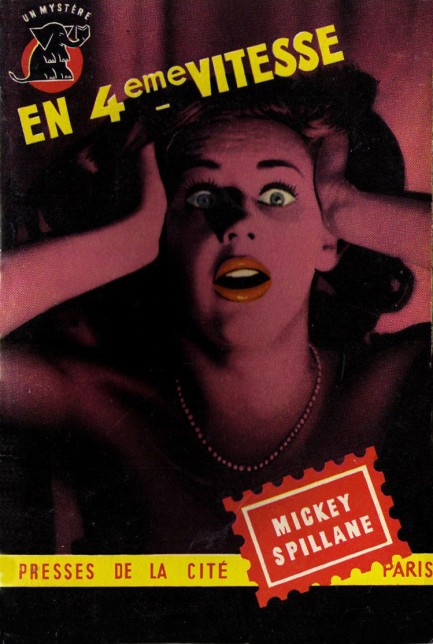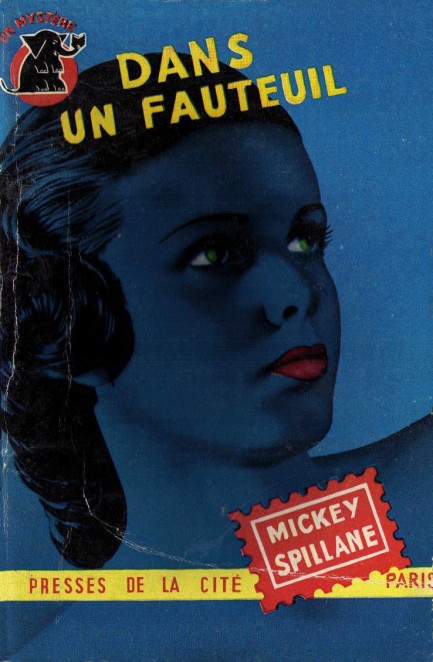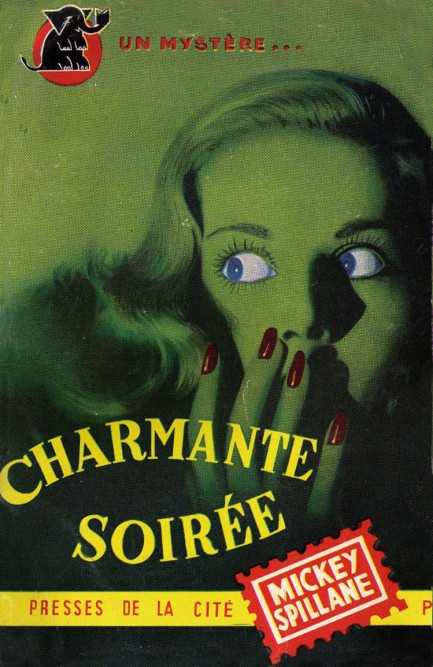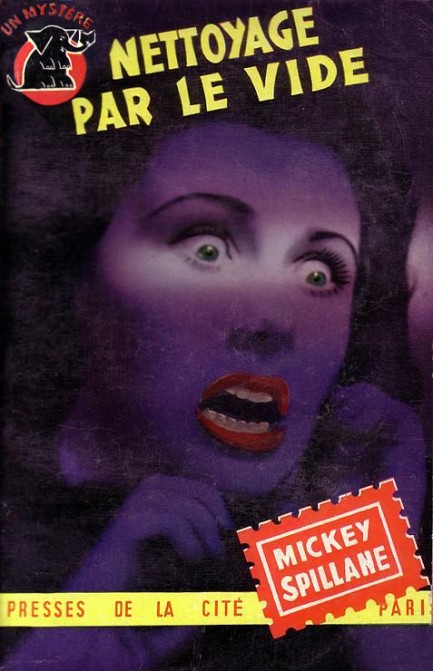| Vintage Pulp | Oct 10 2019 |

Erm... before you shoot... I just want you to know it was all her fault.

Crime en deux temps, or “crime in two stages,” was originally released in 1939 as The Case of the Rolling Bones. For some reason the French publishers of this book, Presses de la Cité, call legendary mystery author Erle Stanley Gardner just Stanley Gardner, which sounds, well, non-legendary. Stanley Gardner is a guy at the office you don't talk to because he's a skin picker. Erle Stanley Gardner is a guy who, if he likes you, can get you into Nobu. So, the Erle is needed.
Plotwise, this revolves around greed, gold, and a group of people who want to prevent their relative from losing his fortune to his prospective wife. In order to stop this imagined horror, they commit the relative to a nuthouse before he can get married. Which backfires when he escapes. As always with Gardner there's a murder, which brings Perry Mason onto the scene to sort everything out.
As you might guess, because Gardner was (and is) an immensely popular author there are several English language paperback covers for this, and they all feature dice in some form. Which makes sense, because the original title came about because there's an actual die maker in the book. He makes crooked dice, and he gets murdered. This uncredited French cover from 1950 caught our eye because of its non-literal approach. No dice, but it's a winner.
Plotwise, this revolves around greed, gold, and a group of people who want to prevent their relative from losing his fortune to his prospective wife. In order to stop this imagined horror, they commit the relative to a nuthouse before he can get married. Which backfires when he escapes. As always with Gardner there's a murder, which brings Perry Mason onto the scene to sort everything out.
As you might guess, because Gardner was (and is) an immensely popular author there are several English language paperback covers for this, and they all feature dice in some form. Which makes sense, because the original title came about because there's an actual die maker in the book. He makes crooked dice, and he gets murdered. This uncredited French cover from 1950 caught our eye because of its non-literal approach. No dice, but it's a winner.
| Vintage Pulp | Femmes Fatales | Sep 26 2019 |

Some people know exactly what they want to do in life. Others need to just feel their way.

Martinique born Sylvette Cabrisseau isn't well known today, but those who remember her will recall that she burst into the public sphere at age twenty as the first black presenter ever hired by the French television network Deuxième chaîne. The event, which occurred in 1969, was not celebrated in all quarters, which resulted in her receiving threats from the usual coterie of knuckle draggers. She later lost her television gig due to modeling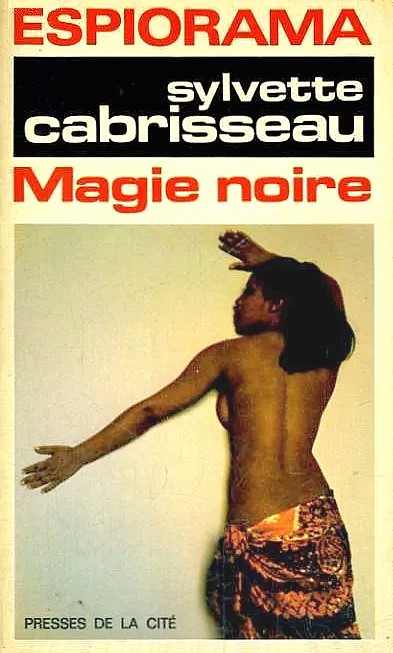 for the above photo (and others).
for the above photo (and others).
 for the above photo (and others).
for the above photo (and others).Nevertheless she was undaunted in her ambitions, and subsequently moved into music, releasing two records, one of them the quirky folk song “Ki Koi Kou.” Next she jumped into cinema with the films Le mariage à la mode and Juliette et Juliette.
Her fifth career choice—and this is the truly interesting part for us as pulp fans—was to write and publish detective novels. As you can see, her image was used to sell the books, which gives you an idea how famous she was at the time.
Her fifth career choice—and this is the truly interesting part for us as pulp fans—was to write and publish detective novels. As you can see, her image was used to sell the books, which gives you an idea how famous she was at the time.
We'd love to acquire these, which we may at some point, since they're available and affordable. We have no info on how good they are, but she did get to publish three, so that may indicate something. After the final novel she moved on to mundane pursuits, but she left behind some nice photos, including the example above, which is from 1970 and appeared in the French men's magazine Adam.

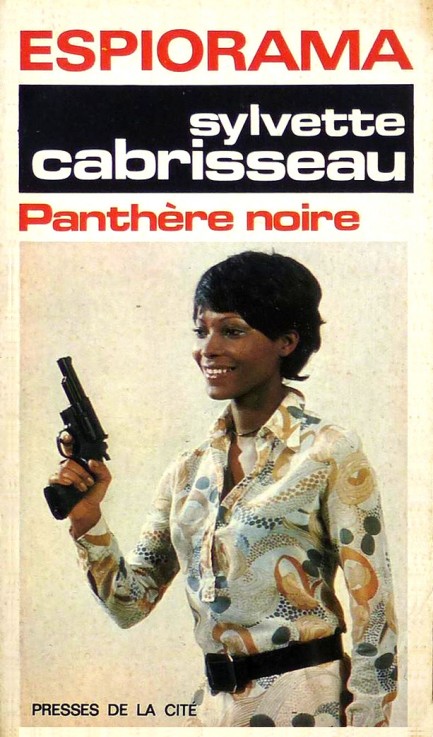
| Vintage Pulp | Nov 24 2017 |

So much for French chivalry.
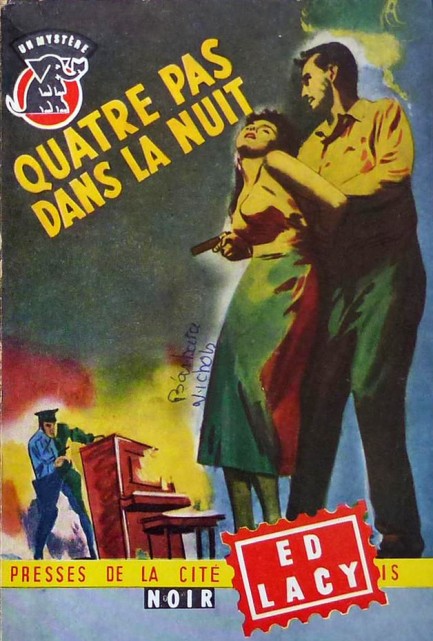
This cover for Quatre pas dans la nuit fits right into our collection from earlier this year featuring ruthless men using women as human shields. In fact, it's the same painting by Barye Phillips used on Ben Benson's Broken Shield, which we included in that previous group. Quatre pas dans la nuit appeared in 1958 and is the French edition of the Ed Lacy novel Be Careful How You Live, which is in turn an expansion of his story "Time Wounds All Heels." We talked about Lacy a bit earlier this year, so if you want to know more check here.
| Vintage Pulp | Jul 23 2016 |

All her problems turned out to be relative.
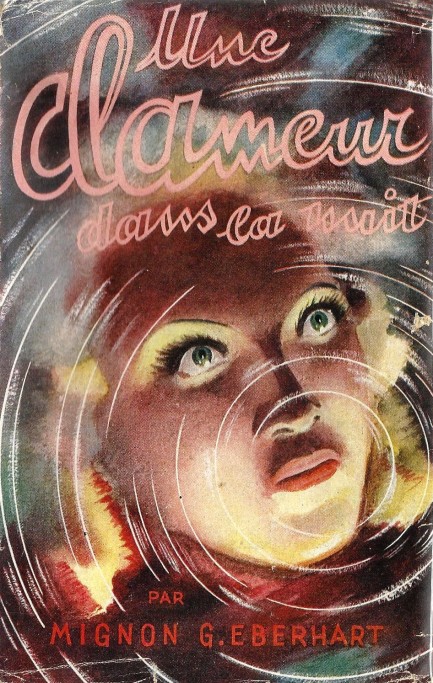
Cool French cover art for Mignon G. Eberhart's 1937 mystery novel Danger in the Dark, also known as Hand in Glove, and released in France by Presses de la Cité in 1947 as Une clameur dan la nuit, which translates as “a scream in the night.” A man means to stop the distant cousin he loves from getting married, but when her fiancée turns up dead the two relatives decide to make the scene look like a robbery to avoid the police suspecting them of murder. But who did the killing? Eberhart had a long and distinguished literary career, typically mixing her mysteries with strong elements of romance and ending up with Christie-meets-Harlequin. This is a prime example, but a well reviewed book.
| Vintage Pulp | Dec 21 2015 |

Yup, there's something here. Based on your personality I'm inclined to say it's a “666,” but no—they're just bruises.
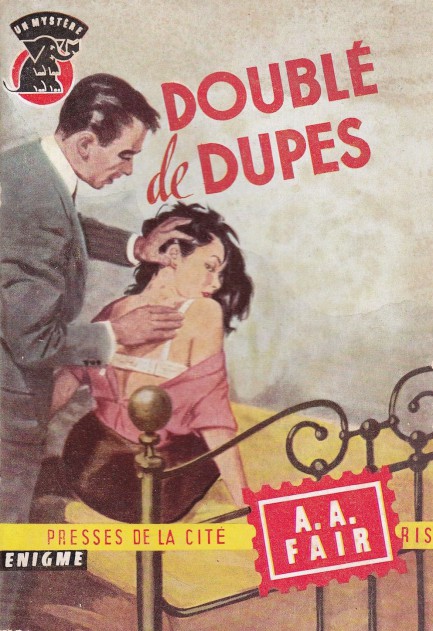
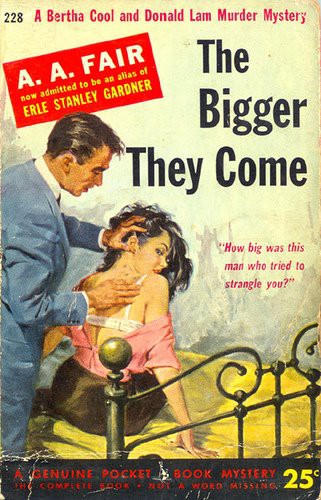 A.A. Fair's Doublé de dupes, which is a translation of The Bigger They Come, was first published in hardback in 1939, appeared as a U.S. paperback from Pocket Books in 1952, and above in 1958. It's the first in a series starring sixty-something private investigator Bertha Cool and her pint-sized sidekick Donald Lam. Fair, aka Erle Stanley Gardner, had already made his Perry Mason series a success and the Cool/Lam shift got him out of the courtroom. In this one the protagonists attempt to serve divorce papers, but of course the seemingly simple task falls apart spectacularly, leaving a man dead and Lam under suspicion of having committed a serious crime. The British version's title—Lam to the Slaughter—gives that aspect of the story away immediately. The curious cover art you see here by Maurice Thomas was used on both the U.S. and French versions (a bit of a surprise considering the six year gap) and shows Lam checking out injuries on the femme fatale, who has been attacked by another character. General consensus online is that this series improved greatly after the first couple of entries.
A.A. Fair's Doublé de dupes, which is a translation of The Bigger They Come, was first published in hardback in 1939, appeared as a U.S. paperback from Pocket Books in 1952, and above in 1958. It's the first in a series starring sixty-something private investigator Bertha Cool and her pint-sized sidekick Donald Lam. Fair, aka Erle Stanley Gardner, had already made his Perry Mason series a success and the Cool/Lam shift got him out of the courtroom. In this one the protagonists attempt to serve divorce papers, but of course the seemingly simple task falls apart spectacularly, leaving a man dead and Lam under suspicion of having committed a serious crime. The British version's title—Lam to the Slaughter—gives that aspect of the story away immediately. The curious cover art you see here by Maurice Thomas was used on both the U.S. and French versions (a bit of a surprise considering the six year gap) and shows Lam checking out injuries on the femme fatale, who has been attacked by another character. General consensus online is that this series improved greatly after the first couple of entries.| Vintage Pulp | Jun 2 2015 |

Spillane decides to kill everybody.
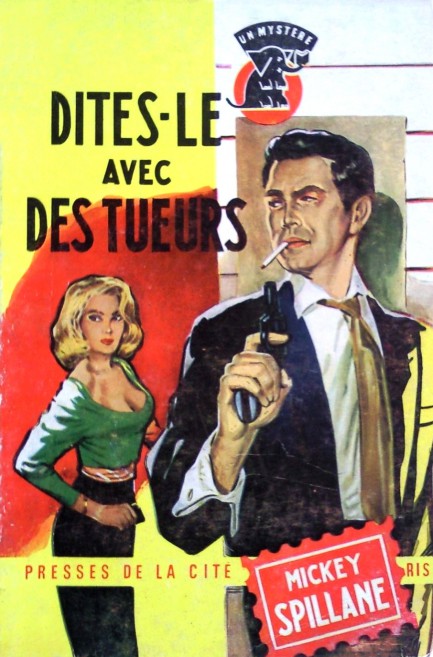
Mickey Spillane’s Dites-le avec des tueurs was published by Presses de la Cité in 1961, and comprised four stories translated into French by G. Morris-Dumoulin—“Stand Up and Die!,” “Tomorrow I Die,” “I'll Die Tomorrow,” and, just for variety, “Me, Hood!” Don’t worry, though—lots of people die in that one too. All four tales originally appeared in the American men’s magazine Cavalier, a publication that embraced writers such as Thomas Pynchon, John D. MacDonald, and Theodore Sturgeon, and was instrumental in helping launch the career of Stephen King. We really like the cover art on the above collection, but we don’t know who did it. We’ll dig into that and maybe report back later.
| Vintage Pulp | Jun 1 2014 |

The books are lovely, dark, and deep.
Below, four evocative covers from the French imprint Editions Les Presses de la Cité for, top to bottom, Mickey Spillane’s En quatrième vitesse (Kiss Me Deadly), Dans un fauteuil (The Big Kill), Charmante soirée (One Lonely Night), and Nettoyage par le vide (The Long Wait). Does that last one sound familiar? Look here. Artist or photographer unknown on these. You can see more excellent Presses de la Cité Spillane covers on Müller-Fokker’s blog.